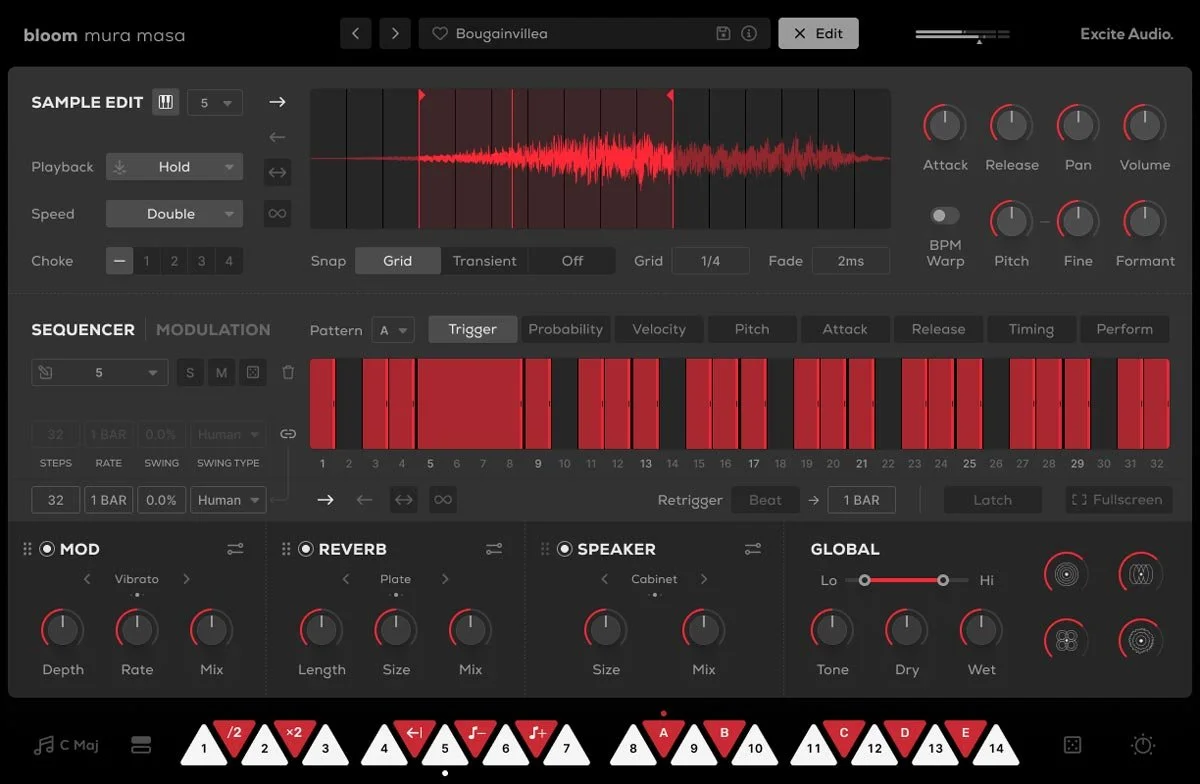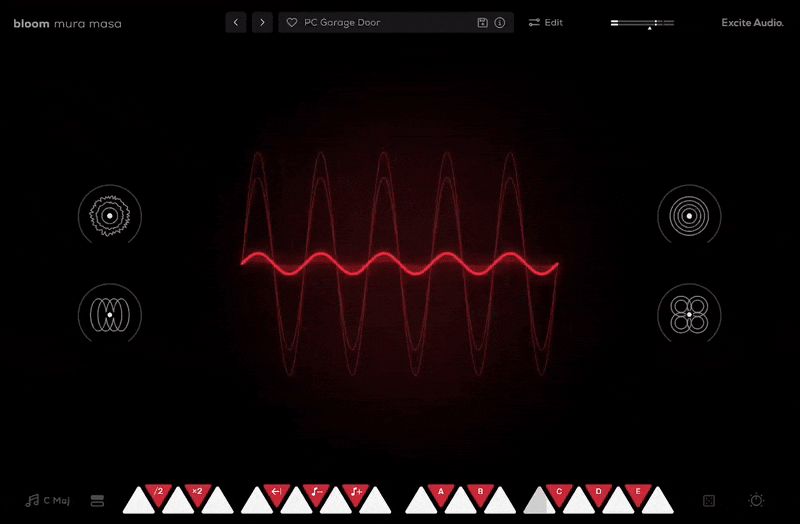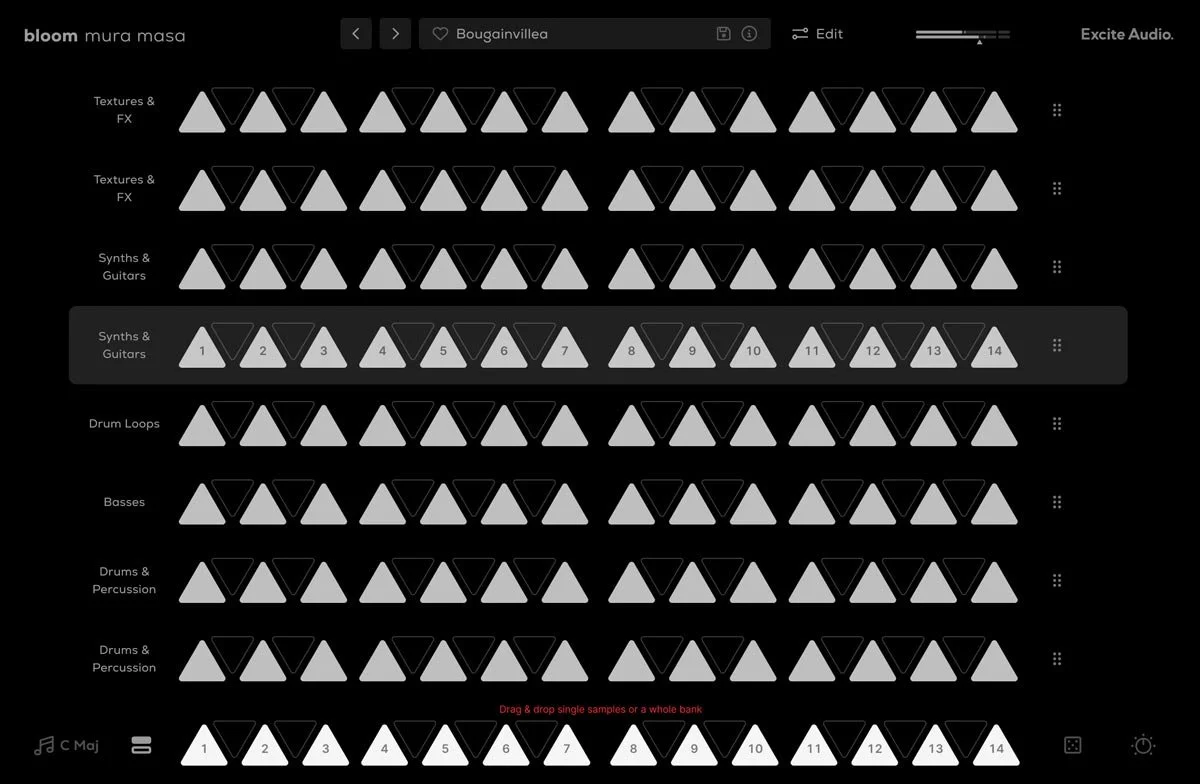Bloom Mura Masa: Forward-Thinking Club Sounds in a Box

Club music has been getting rougher around the edges again. The glossy era of hyper-polished EDM and preset-driven “festival drops” feels passé — what’s breaking through now has dirt under its fingernails, emotion in its bones, and a certain unruly swing that makes dancefloors feel alive. Between the resurgent influence of UK garage, the darker rave lineage creeping back into pop, and a new generation of producers embracing imperfection, there’s a real sense of club culture circling back to rawness and vulnerability — but without nostalgia cosplay. That’s exactly the space Mura Masa has been carving out: emotional, slightly jagged, deeply human club music that feels like a sweaty basement party at 3AM, narrated by someone who still wants you to feel something. Bloom Mura Masa taps right into that energy. Built from his personal session archives and shaped around Excite Audio’s Bloom engine, it isn’t framed as a “preset pack” or a bundle of genre loops — it’s an instrument designed to spark ideas and encourage performance-driven production. You get warped percussion, intimate textures, gritty bass stabs, and rhythmic fragments that feel alive rather than locked to a grid. It’s club-ready, emotional, and just unpredictable enough to remind you why making dance music can be exciting in the first place. If you want tracks that breathe rather than merely function, this release feels like one of the more compelling tools in that movement.
This site contains affiliate links. If you book or purchase through these links, I may earn a commission at no extra cost to you. This helps support the site and keeps my content free. As an Amazon Associate, I earn from qualifying purchases.
What Is Bloom Mura Masa?
Bloom Mura Masa is a new artist-driven instrument powered by Excite Audio’s Bloom engine, built in direct collaboration with Mura Masa and sourced entirely from his own session archives — the same sonic palette behind his album Curve 1. Rather than curating generic club samples, he’s digging into the textures that define his world: gritty low-end pulses, shuffled UKG percussion fragments, hyper-emotive pads, rave-coded synth chops, and little bits of chaos that feel like they were sampled straight off a warehouse wall at 4 a.m. The result isn’t a style preset; it’s a glimpse into his private sketchbook of sounds, repurposed into something you can play, twist, and perform with.
Where typical sample packs stop at “drag and drop,” Bloom Mura Masa positions itself as an instrument. It runs in the Bloom interface, giving you access not just to the sounds, but the workflow behind them — sequenced loops, generative rhythmic tools, macros built for improvisation, and the ability to turn a single phrase into something textured and personal. It’s a platform for club music that values instinct and movement: you trigger, you bend, you react. If you want a tool that hands you a vibe instead of a finished loop, this one feels purpose-built for that moment.
Sound & Style: Club-Ready, Emotional, Anti-Nostalgic
Bloom Mura Masa lives in the tension between grit and tenderness. You get snarling bass stabs, mangled breaks, and jagged percussion that wouldn’t feel out of place in a sweaty South London basement — but right next to them sit fragile pads, ghost-melody vocal flickers, and textural loops that feel private, almost diary-like. There’s this continual push and pull between immediacy and introspection: the energy of a rave and the emotional weight that lingers after you leave. It’s a palette tuned to movement, but with an aftertaste of longing — the way UK club culture has always smuggled melancholy into moments of euphoria.
Rhythmically, it leans on the classic Mura Masa DNA: UKG shuffle, post-dubstep swing, restless syncopation, little bursts of percussion that feel chopped from a live take rather than quantized into submission. The drums and loops don’t sit in tight lines — they sway, stumble, snap back, and pull forward. This unpredictability gives tracks a human quality, the sensation that something might glitch or topple but somehow always lands on beat. There’s a thrill in that looseness, the refusal to polish everything down to a digital edge.
And while it nods to rave history — breakbeat accents, stabby synths, hardcore cadence — it never feels like retro worship. These sounds don’t try to recreate a specific decade; they push toward something else entirely: a DIY futurism grounded in lived club experience rather than nostalgia mood-boarding. This is the emotional underbelly of modern dance music: vulnerable, jagged, hazy, euphoric, and a little bruised. If you’re drawn to the wave between underground warehouse tension and soft-hearted electronic pop, the sonic world here feels like home.
Inside the Bloom Engine: Fast, Playful, Performance-Ready
What makes this instrument hit different isn’t only the source material — it’s how Bloom lets you play with it. Instead of dragging loops onto a grid and sculpting them into something usable, Bloom encourages you to perform ideas into existence. Phrases twist, rearrange, and mutate in ways that feel spontaneous rather than programmed, and it’s genuinely hard to create something static or boring. It’s built for producers who think with their hands first — tap something in, tweak a macro, stumble onto a pocket you never would've found sequencing bar by bar.
The sequencing engine here excels at organized chaos: rhythmic fragments lock together, then tear apart, then find their way back; loops behave like moving organisms rather than fixed samples. There’s an improvisational quality that pulls you into the moment — the kind of workflow where you stop over-thinking and start reacting. Happy accidents aren’t a bonus, they’re the creative method. And when something hits, it hits with the raw electricity of a live take.
Then there are the macros. These aren’t decorative — they feel like performance controls baked into the sound’s DNA. Twist one, and a texture folds in on itself; twist another, and the percussion tumbles into polyrhythmic chaos before snapping back into place. For live sets, hybrid performances, or just building a beat that breathes instead of looping aimlessly, Bloom makes movement feel effortless. It’s less “sound library” and more club instrument disguised as a plugin, and that difference becomes obvious the second you start playing with it.
Click here to explore the full Bloom lineup
How It Compare To the Competition
What sets Bloom Mura Masa apart from other modern sound releases isn’t just the source material — it’s the philosophy. Compared to typical sample packs or preset bundles, there’s a sense of authorship and intention baked into every sound here. The original Bloom library already leaned into experimental phrasing and performative sequencing, but this edition feels more emotionally defined, less like a toolkit and more like a point of view. If the first Bloom was a playground, this one feels like a dark club corner where something beautiful and chaotic is about to spark.
Against subscription platforms like Output Arcade or Splice, the difference is workflow. Those platforms are incredibly useful, but they encourage a drag-and-drop mentality; sounds often arrive as fixed shapes. Bloom Mura Masa, by contrast, wants you to mold, bend, and actively participate in the sound. It’s built for expression, not assembly. You don’t just browse until you find the loop that fits — you play the loop into fitting, or let it surprise you into a new direction entirely.
You could also compare it to curated Ableton Packs — strong sound design ecosystems with big sonic range. But even there, Bloom has a different DNA. Most add-on libraries behave like menus; this behaves like a collaborator. It’s closer in spirit to an instrument than a folder of assets, and that distinction shapes the experience. When you use this, you don’t feel like you’re choosing sounds — you feel like you're sparking ideas. If the current wave of left-field club music is defined by immediacy and emotion, Bloom Mura Masa fits right into that cultural shift.
Pros & Cons
Pros
Curated directly from Mura Masa’s personal session archives
Bloom engine encourages improvisation and “happy accidents”
Perfect for left-field club, UKG, rave-pop, and intimate electronic textures
Sounds feel emotional and lived-in, not generic or over-processed
Functions more like a playable instrument than a sample library
Inspires fast ideas and fluid, performance-driven workflows
Cons
Not suited for hyper-slick, rigid EDM styles
Less appealing if you prefer strict grid-based programming
Bloom workflow may feel unfamiliar to sample-draggers and loop browsers
Aesthetic leans niche — raw, emotional club music rather than mainstream pop polish
The Verdict
Bloom Mura Masa is less a collection of sounds and more a doorway into a particular creative mindset — one where club energy doesn’t have to sacrifice vulnerability, where rhythm feels unstable in the most beautiful way, and where texture and emotion sit right at the surface. It thrives on instinct and movement: you poke at a phrase, it writhes and evolves, and suddenly you’re somewhere new, somewhere messy and intimate and full of possibility. In a landscape overflowing with packs and presets, this feels like an instrument with a pulse.
If your music gravitates toward left-field club culture, post-garage swing, rave-tinged melancholy, or that blurry zone where rhythm and feeling blur into one another, Bloom Mura Masa will likely become a go-to spark. It rewards curiosity more than control, and it favors immediacy over perfection — which is exactly why it hits so hard in this moment. But if your sound lives in pristine, quantized worlds, or you need every detail fully obedient to the grid, you'd probably connect more with traditional libraries.
For producers chasing emotion, movement, and that sense of catching a moment before it slips away, this might be one of the most creatively useful instruments released this year. It doesn’t just give you the tools to build club tracks — it gives you a mood, a pulse, a feeling worth following.
This site contains affiliate links. If you book or purchase through these links, I may earn a commission at no extra cost to you. This helps support the site and keeps my content free. As an Amazon Associate, I earn from qualifying purchases.



